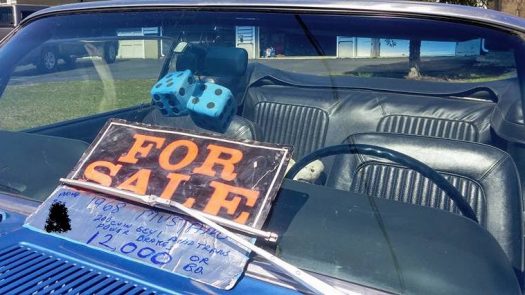By Barbara O’Neill, Ph.D., CFP®, Rutgers Cooperative Extension, [email protected]
Personal Financial Management (PFM) program staff often counsel military families about the financial implications of “big ticket” purchases. “Big ticket” means that items cost more than most people can afford from a single paycheck including furniture, computers, electronics, appliances, and cars.

Mustang Sally. Photo by Barbara O’Neill
After a house and college education, a car is the largest purchase that many families make. With a $33,560 average price of a new car, it pays to take the time to shop around. The most important point to remember, before visiting a car dealer, is that “everything is negotiable.” Many car buyers are not good negotiators, however. Two alternatives are hiring a car-buying service or asking a friend to negotiate for you.
Car buyers must weigh the pros and cons of new cars versus used and buying versus leasing. New cars will cost less for repairs, because of their warranties, and can be custom ordered to an owner’s specifications. The downside is depreciation, or loss of value. Used cars are less expensive to own because the previous owner(s) absorbed much of the depreciation. They may also need more repairs because of their age and condition.
Below are seven recommendations to share with service members who are buying a car:
- Do Some Math- Compare low-interest, even zero interest, financing and cash rebate deals using an online The better alternative will depend on two main factors: how much below market interest rates the lower rate dealer financing is and the repayment period of the loan. Savings from a low interest rate decreases as the repayment period shortens. Attractive cash rebates and other incentives are most likely to be offered on models with a slow sales record.
- Do Some Research– Check out car pricing web sites such as edmunds.com and www.kbb.com before visiting dealer showrooms and carefully review local auto advertisements. Find out the dealer invoice price or, better still, the dealer’s true cost after manufacturer bonuses and incentives.
- Keep Transactions Separate- Negotiate each part of the transaction- car purchase price, financing, and car trade-in price- one at a time. Otherwise, it is easier for a car dealer to get a higher markup by offsetting a low price in one area with a higher price in another. Settle on the new car price first and get it in writing. Then get a price for a trade-in, if any, and dealer financing.
- Compare Dealer and Non-Dealer Prices– Compare the dealer trade-in price and loan interest rate with other alternatives (e.g., a private sale of your old car and a car loan made through a bank or credit union).
- Consider Buying a “New Used” Car- Compare the cost of a 2- to 3-year old “new used” car to a brand new car. Many late model used cars cost 30 to 40 percent less than new models because cars depreciate the most during the first 3 years of ownership. Some may even have the remainder of the original manufacturer’s warranty or a new extended warranty provided by the dealer.
- Avoid Being “Upside Down”- Make a sufficient down payment and avoid long-term (5+ years) car loans so that a car is not worth less after depreciation than the amount of money owed on it.
- Beware of Privately Sold Used Cars- Consumer Reports magazine recommends only buying used cars with a good history of reliability. This information can be found in its annual April car-buying issue. Generally, sales between individuals are on an “as is” basis. Ask the owner for available maintenance records, take a car being considered for a test drive, and/or pay a mechanic to do a professional inspection.
The Iowa State University Extension publication Owning a Car has additional information about car buying.














